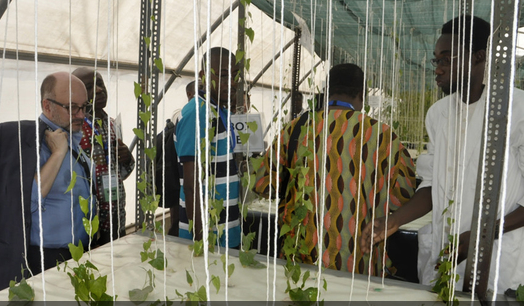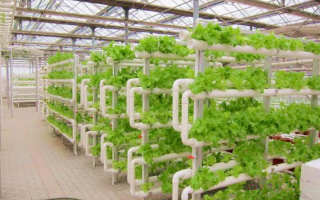Aeroponic system is the Africa's agriculture future?
FOR BLOGGERS and PARTNERS.
Do you want to manage loans and wáter projects from Middle East to Africa?
or your African country in aeroponic system industry?
Contact us here, mayado@sylodium.com for be our blogger managing Middle East – Africa loans and projects, so managing all the niches related you choose: Ghana – UAE Water projects, Nigeria aeroponic systems, Africa – GCC funding projects, etc, etc, endeless related
Another option is being our collaborator in your African country if you consider as a good thinker, visionary, hard studious, you can become our blogger or our partner in Nigeria, Tanzania, South Africa, Egypt in relationship with any Arab country…. contact us. mayado@sylodium.com
FOR COMPANIES AND INSTITUTIONS:
Tap our unique Crossing System. SYLODIUM: the business language
New from Mail & Guardian Africa
Africa's future? Where food and fodder will be grown in air, using 98% less water
FARMERS across Africa face increasing challenges year in and year out. They have to adhere to planting seasons thrown into turmoil by climate change, are vulnerable to weather variations, the high input costs of farming in terms of fertilisers, pesticides or herbicides and, increasingly, seeds and climate change.
One young Nigerian who is on a mission to change all this is Samson Ogbole, the founder of Sreach Aeroponics - an organisation which aims to train people on how to build and maintain systems where plants can be grown in the air.
This means that everything from lettuce and tomatoes can be grown without soil and this can even be done indoors.
In an interview with Mail & Guardian Africa, Samson explained that he was first introduced to this soil-less system at the International Institute of Tropical Agriculture, where he studied for a year, after which he was taken on as a staffer and put in charge of an aeroponic system.
“It’s a simple idea”, he said, “in aeroponics, plant roots aren’t in soil instead they’re secured to a support platform and held in place at the stem by foam so that the root system hangs below in an enclosed or semi-enclosed chamber.”
“A pipe, which is connected to a pump and timer, brings nutrients - whether organic or inorganic - dissolved in water and sprays it onto the roots. It’s not a complicated system, which many people think it is, all they need to do is monitor the nutrient to make sure it doesn’t finish!”

(Diagram/hydroponicpassion.blogspot.com)
“I can teach people how to make their own organic nutrient solution, but for those that prefer inorganic, you have to buy chemicals the way you buy fertilisers.”
Samson explained that there are huge benefits of having plants literally grow in “thin air”, free from soil borne pests and soil pollution.
Very fast growth
The system can reduce water usage by 98%, fertiliser usage by 95%, pesticide usage by 99% and can increase crop yields by 45% to 75%. It also enables faster growth of up to 3 to 5 times faster than conventional growing in soil. Lettuce for instance, in traditional systems, can be grown from seed to harvest in 70 to 90 days. While aeroponics growing would take just 25 to 30 days. Other plants proved to also have fantastic yields as a result of the system include; beans, cucumber, tomatoes, peppers and ginger.
But it isn’t all rosy. Samson also explained that there are three big limitations and drawbacks to using this system; there needs to be 24 hour electricity (though some are turning to solar energy to overcome this), the technical ability to know how to maintain and set up the system and, if done on a big commercial scale, the initial set up will be expensive. “But no matter how expensive – in the first year your returns are huge”, he said.
Samson’s newly founded company is currently producing custom-built aeroponics systems - made to the specification and space requirements of the client.
To get an idea of cost he gave the example of a 5m by 1m lettuce aeroponics farm. The total cost for the system is 457,000 Naira ($2,290).
This is a high cost but the production predictions were impressive.
A square metre will contain 50 holes which means 50 plants. In this design there are 10 square metres, thus housing a total of 500 plants. In the case of lettuce, every 30 days, 500 plants will be harvested from this aeroponics system. This compared to a traditional farming system in which Samson claims a space of 10 square meters would produce 500 plants after 90 days - 3 times as long.
Larger scale
How realistic is it to roll this out on a larger scale?
Big aeroponic systems can be made though there are limitations as to what can be grown. Root vegetables can start their growing process in this system but will eventually have to be transferred to soil to become harvest ready.
However, it has been shown that starting the process with aeroponics is very useful in producing seeds and healthier crop for root vegetables too. The International Institute of Tropical Agriculture (IITA) in Nigeria for example has a project called the Yam improvement for income and Food Security in West Africa (YIIFSWA) which uses aeroponics. The system produce seeds, vine cuttings and mini tubers which they then hope to make readily available and affordable for yam producers in Nigeria and Ghana.
Speaking to Morufat Balogun from the project she said that this has “changed the yam seed system”. The system has improved the “quality of material planted in terms of seed health, vastly increased yields and seen tubers grow vigorously”.

Fodder
But it isn’t just food and seeds that can benefit. The aeroponics can also be used to combat one of soil’s greatest adversaries and one of our greatest challenges: climate change.
In an interview with Louis Visser of Qwik Gro aeroponic systems in South Africa, he said that their “[aeroponic] systems are more specifically designed for growing economical livestock fodder 365 days of the year, in a controlled environment, notwithstanding prevailing droughts.” This means that this system provides a consistent source of high quality, nutritious feed regardless of the weather, all year round!
For example, they are now in the process of constructing a feedlot for a 6000 lamb feedlot on 3.5 hectares of land and going to duplicate the same in Cape Town.
Systems like this offer one more option when looking at increasing the adaptive capacity of farmers, communities and governments to respond to the impending impacts of climate change.
Artificial Intelligence - 21/02/2018
Artificial Intelligence - 07/02/2018
Artificial Intelligence - 15/12/2017
Artificial Intelligence - 27/11/2017

